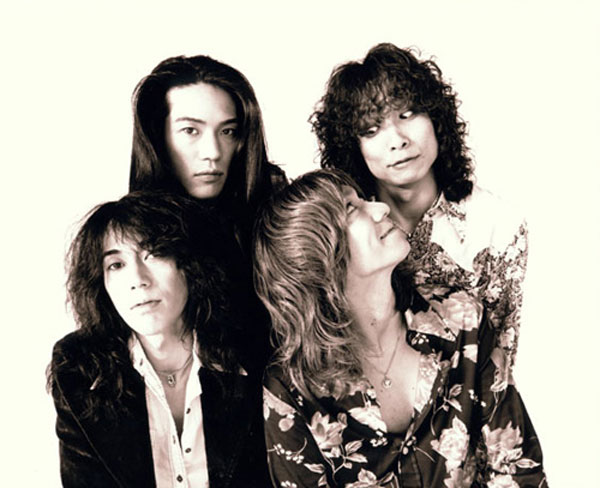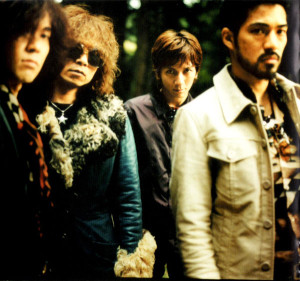There are always those bands that are famous in Japan, but barely any international listeners seem to know. The Yellow Monkey is one of the biggest examples of this phenomenon. I’ve decided to create a series of articles that will detail not only a history of the group, but also provide translations and linguistic analysis of all of their music. You won’t find much music criticism here, it’s not my strong suit. But first I hope that you’ll humor me as I explain my personal history with the group.
Like many J-Rock fans who were set on their paths by watching anime in the ’90s, I first discovered The Yellow Monkey from hearing “Tactics”, the first ending theme song to the Rurouni Kenshin TV series. The theme songs for that series were quite revolutionary; most anime used songs written specifically for the show, but Kenshin broke the mold by using popular music instead. Even so, none of those songs hit me in quite the way that Tactics did. Unlike a lot of Japanese music I had heard up until this point (most of it being through anime), this song had so much in common with the American and British rock that I had been listening to for years. At the time I didn’t know very much Japanese, so I was only able to understand the lyrics through the accompanying subtitles, but it intrigued. I had to find out more about The Yellow Monkey.
Downloading Japanese music in 2000 was difficult at best, so buying a CD was often the only option to hear new music. After a bit of searching I found CD Japan, and right there on the front page was an advertisement for a newly released album by The Yellow Monkey called “8”. I took it as fate and ordered it right away. I was so blown away by what I heard on that album, I went all the way back to “The Night Snails and Plastic Boogie” (their first major label album) and devoured their discography. I’ve discovered many artists that I love since then, from all over the world. None of them have had as profound of an impact on me as The Yellow Monkey have, and I hope that these articles will show exactly why that is. They inspired me to both learn more about music and to study Japanese (I had quite an uphill battle there – these lyrics have proven to be some of the most complex and abstract that I’ve seen), have gotten me through some difficult times and will always be a very important part of my life.
Now, let’s introduce the band. The Yellow Monkey (or “Yemon” for short) is:
Kazuya Yoshii (Lovin) – Vocals, Guitar
Hideaki Kikuchi (Emma) – Guitar
Youichi Hirose (Heesey) – Bass
Eiji Kikuchi (Annie) – Drums
(Throughout these articles I will refer to Yoshii by his real name, whereas I will refer to the other members by their nicknames).
The name “The Yellow Monkey” comes from a derogatory term used by Westerners to refer to Asian people in general (though I’ve certainly not heard anyone use this). Apparently Yoshii wanted to go with an unsophisticated, cynical name, and had decided on this one before the band was even formed in 1988. Yoshii started his music career as a bassist for a band called URGH POLICE, one of the leading groups (along with the groups that the other members came from) in the trending “Japa-Metal” sound (the Japanese take on LA metal and glam rock). Yoshii was a bit pudgy as a teenager, and the story goes that he was let into the group under the condition that he had to lose 10 kilograms (a condition that he obviously met). He began in The Yellow Monkey on bass, but soon switched to guitar when he invited Heesey (whom he was acquainted with, and previously from the group MURBAS) to come in as the bassist. From there Annie joined the band on drums after KILLER MAY, a band he was with previously that had made their major debut in 1986, broke up. The vocalist of the group up to this point soon left the band, due to musical differences with Yoshii. Yoshii then switched from guitar to vocals, and Emma (Annie’s actual older brother) joined the band on guitar. He had also been the guitarist for the aforementioned KILLER MAY, his first official performance with The Yellow Monkey was on 12/28/1989. The group’s early live performances were primarily at a live house in Tokyo called Shibuya La.mama.
Yemon has always worn their influences on their sleeve, both musically and stylistically. Of course those influences include British rock standards such as The Beatles, The Rolling Stones, Led Zeppelin, David Bowie (this is perhaps more obvious in a stylistic sense, as most of Yoshii’s early looks can be easily traced back to Bowie) and Mick Ronson. But if you look particularly at the early part of Yemon’s career, you’ll also notice a lot of glam rock influence there as well (they didn’t exactly lose it at they matured, it just got mixed in with a lot of other things). Anyone who is familiar with T. Rex, New York Dolls or Mott the Hoople (from whom Yemon has taken the most from) will find a lot to recognize.
From here I’ll be looking at Yemon’s career album by album, and in chronological order. I’ll discuss what was happening with the band at that time, as well as go as in depth as possible into the meaning of the lyrics of each song. They’re sometimes sexual, sometimes profound, and often contain endearing misuses of the English. Try to listen to each song as you read these analyses if possible (YouTube links to performances will be provided when possible, but these shouldn’t be treated as substitutes for listening to the actual albums). If you’re already familiar with Yemon, then I hope you’ll learn something new. If you’re not, then “Welcome!”.
Albums/Landmarks
| Bunched Birth | 07/21/1991 |
| The Night Snails And Plastic Boogie | 06/21/1992 |
| Experience Movie | 03/01/1993 |
| Jaguar Hard Pain | 03/01/1994 |
| smile | 07/21/1995 |
| Four Seasons | 11/01/1995 |
| Jam, Spark and Changing Labels | 02/1996 – 07/1996 |
| Sparkle X | 05/29/2024 |
Books
| So Young – A Collection of Yoshii Kazuya’s Lyrical Poetry | 04/10/1999 |
| In Search of Lost Love – The Autobiography of Kazuya Yoshii | 12/25/2007 |
Interviews
Misc
| Super Big Egg 2017 Report | 12/10/2017 |


